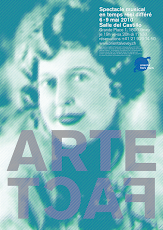Artefact was imagined by Dragos Tara as the result of his various collaborations with the duet 1+1 (Ann Gillot: recorder, Laurent Estoppey: saxophones).
This collaboration is defined by the identity of 1+1, an anti-duet that plays either as two separated instruments or as a single instrument (in complete unison).
The common projects of Dragos Tara and 1+1 mixe composition and improvisation and give a particular place to electronics.
The stage and sound relations between this defeated duet and electronics are the source for musical pieces brought under the name of Artefacts.
The sight and sound scénettes of Artefact lead the duet into musical situations in an era where the notion of virtual reality has entered the every day language. :
One witness a dilated dialogue, as if a chat of a few seconds was stretched over a whole hour. Instead of direct confrontation, communication takes place through live electronics. The musicians face their own picture (video and sound recording).
The main actor is the duet 1+1, immersed in sound asmuch as the public through the use of ambient loudspeakers.
The narrator of this project is Florence Foster Jenkins, an eccentric American multimillionaire convinced to be a big lyric voice in spite of sniggering of both criticics and public. She died in 1944. Recording of its concerts of the forties in Carnegie Hall is used as a voice-over.
For this project, i twas seemed appropriate to extent these sound relationships to the visual. Nicole Seiler’s video work echoing these themes, the collaboration was broaded.
Appearances
The audience is immersed in sound by loudspeakers scattered in the room on sides, behind or among the public.
The dialogue falls appart: the recorder communicates with the video or sound recording of the saxophone. The live electronics use the information of one of the instrument to taint the sound of the other one. So, in Choses, the flute plays with a recording, while being itself recorded. Then the saxophone plays with this new recording and is recorded, and so on…
The recording of Florence Foster Jenkins, that can be heard througho
 ut all show, reveals the breaks in communication, in the same way a narrator can make us feel remote from dramatic action. The quality of these tapes (digitized gramophones of the forties) first establishes a distance , and makes the tapes them recognizable even with sound manipulation.
ut all show, reveals the breaks in communication, in the same way a narrator can make us feel remote from dramatic action. The quality of these tapes (digitized gramophones of the forties) first establishes a distance , and makes the tapes them recognizable even with sound manipulation. The obvious absence of voice and ear of Florence Foster Jenkins, eccentric millionairess convinced to have a great lyric in amidst her fantasies, also creates this distance.
But distance is reduced as electronic manipulations distort the soundtrack. The voice follows the opposite way to that of the instruments. Florence Foster Jenkins gains in momentum as she is manipulated, becoming sound mass while the recording reference is lost. She haunts the instrumentists, as in Stratégies, she duels with the flute, fighting for a broader sound diffision and ta better occupation of space.
Strategy of the bug
The parasites of the sound are in the heart of this composition, inspired by electronic processes with a corrosive effect on sound. This music of bugs goes beyond recording and taintes the sound of the instruments, inspiring their way of playing.
Sound diffusion follows the same logic, using loudspeakers of various qualities, each for its special qualities, sometimes even for its flaws. The acoustic spaces are the continuation of stage design in the world of sounds.
Video
Beamers are used as well as televisions The musicians themselves are the base material, and are even used as screens, for their own image as well as the other instrumentist image. Reherseals, preparations are filmed and play a part in the show.
Underlying ideas
The project of Artefact is to use illusion as a character in itself, to play on with the degree of realism in a representation.
Definitions : Artefact and virtuality
Artefact: disturbance due to the interferences in the techniques of observation.
In its broad sense, the artefact is a phenomenon generated (generally involuntarily) by the observer that tampers with him and the object of his perception.
In sound technology, the artefact refers to the involuntary alteration of a sound resulting from sound manipulation. This notion of altered observation can be applied to any on stage representation in so far as it is a reflection of reality. The level of realism in representation varies depending on the quantity of artefacts that came un line.
Virtual: Which has the qualities of the real world without being part of it
In the grey areas between illusion and reality in which artefacts bring the audience, objects are not part of the real world but imitate some aspects of it. A show confronts us with this alternate reality.
Speaking the virtuality of sound, the recording studio changed something in our listening and dissociated sound from its real source.
As part of a concert, live electronics, by means of the transformation of sound and the simulation of acoustics, play with these same codes. If some sound manipulations make us forget that we are in presence of a recorded band or of a modified instrument, other manipulations remind us of it.

